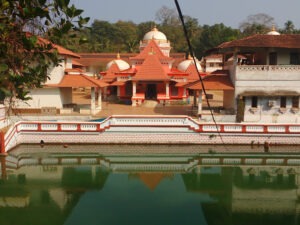Architectural Elegance:
Temple which faces west has beautiful water body with noticeable black granite Nandi bull at the entrance. The tank’s water, always flowing and as clear as crystal, is famous all over Gomantak. Lesser known temples such as Poorvachari, Betal and Raval Nath can be seen in the vicinity. When visitors step into the temple, they feel a spiritual attraction. The Linga is situated in the “Garbhagara” beneath a roof that’s shaped like a dome, with an assigned spot for doing “Pradakshina.” A square area covered with marble tiles faces towards a bedroom containing a bedstead. Shri Laxminarayan and Shri Ganapati idols are placed on the South and North sides respectively. The mandapa displays detailed woodwork that tells stories from Hindu epics, and within the boundary of the temple there is a five-storey deepstambh.
The temple shows a basic but sophisticated layout, mirroring the customary architectural pattern of Goa. The innermost holy place is decorated with complex sculptures, displaying the region’s excellent artistry.
In the area of the temple, followers might find little places of worship for different gods that add to the holy atmosphere. The grounds of the temple are kept nicely and this peaceful surrounding motivates worshippers towards deep prayer.
Historical Roots:
The Shri Nagesh Temple in Bandora’s history is deeply connected with Goa’s cultural background. Many worshippers think that the temple was sanctified a long time ago, which makes it an important storage of historical and cultural importance.
This god previously had the name Nagnath, as shown in a copper plate from 1222 Saka (1300 A.D.). It cannot be disputed that there is an inscription inside the Devastan compound, which clearly proves how ancient this temple is. This is about a land gift called “Veda khandikechem Kulgar,” “Nagzri Mallo, paddy field,” and “Ruvi Kulgar.” Shri Mayeen Shenvi Wagle, an officer from the kingdom gave it. He did this to honor two gods: Shri Nagesh and Shri Mahalaxmi for their service on Kartik Poornima in 1413 A.D., or 1335 Saka.
This time was when King Veer Pratap Devaraya of Vijay Nagar ruled. Inside the temple area, people have found small statues of two more gods -Shiva-Paravati and Ganesh. These idols’ sculptures clearly show who the archaeologists are.


 Source-Wikipedia
Source-Wikipedia 